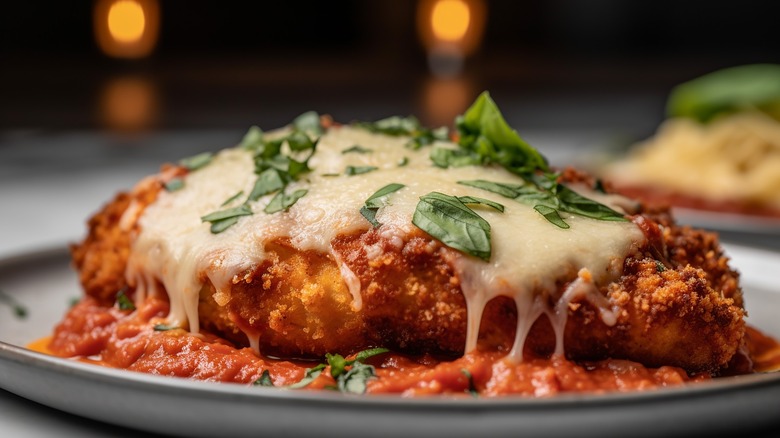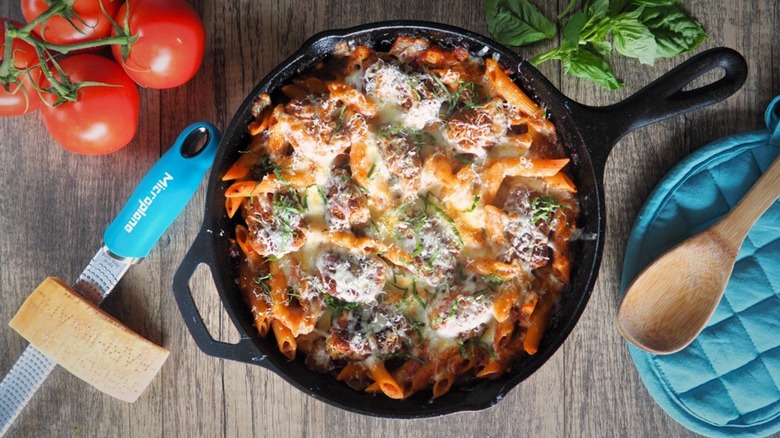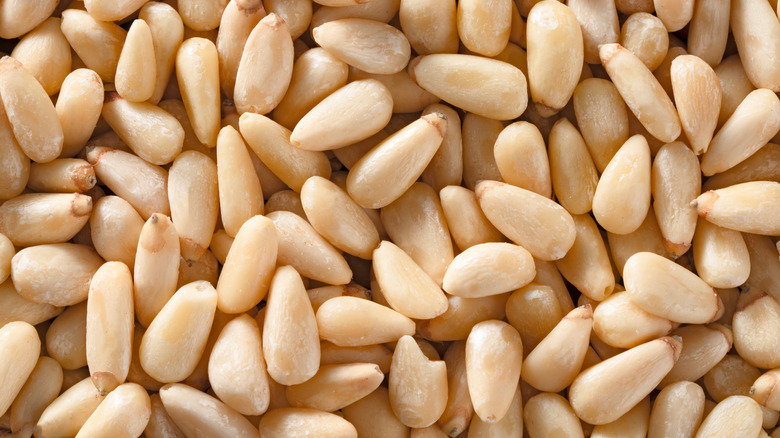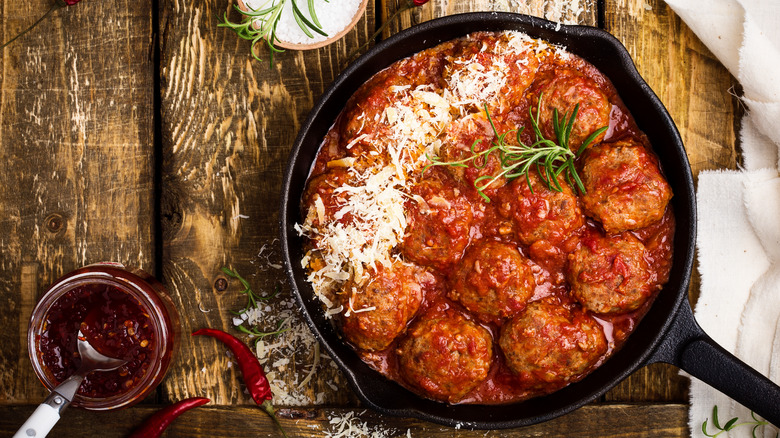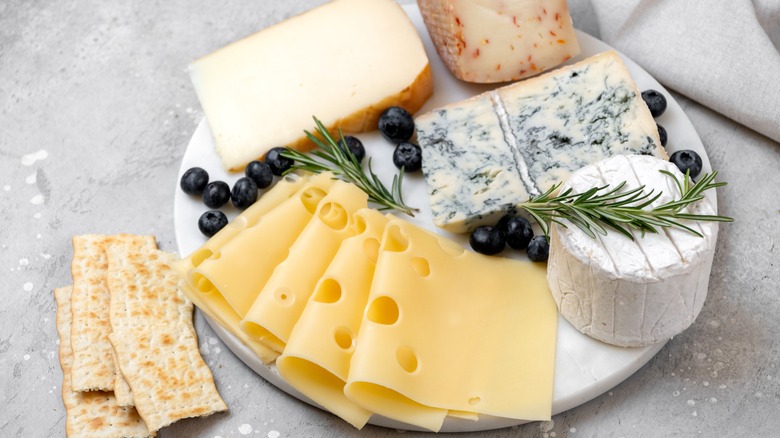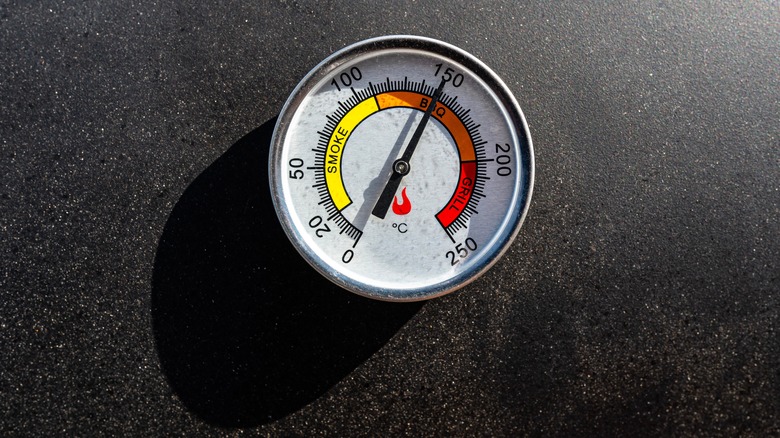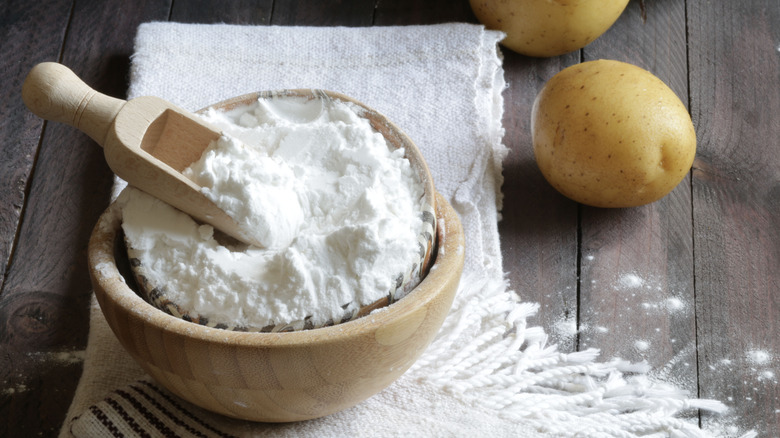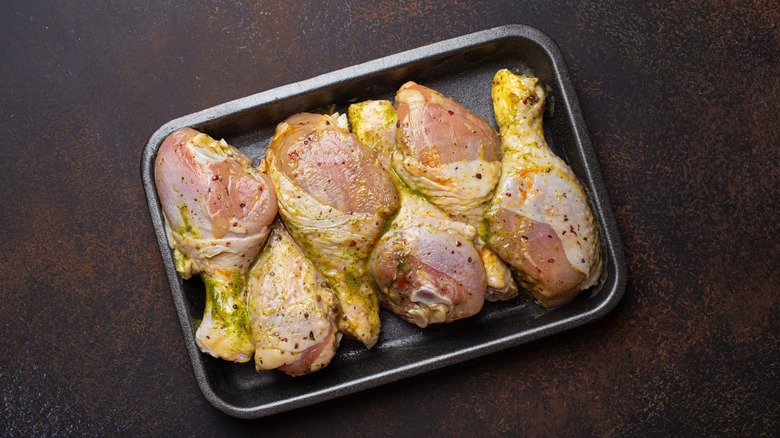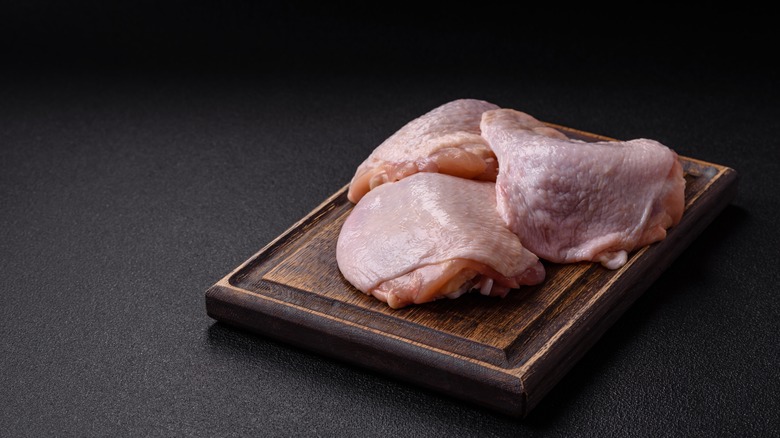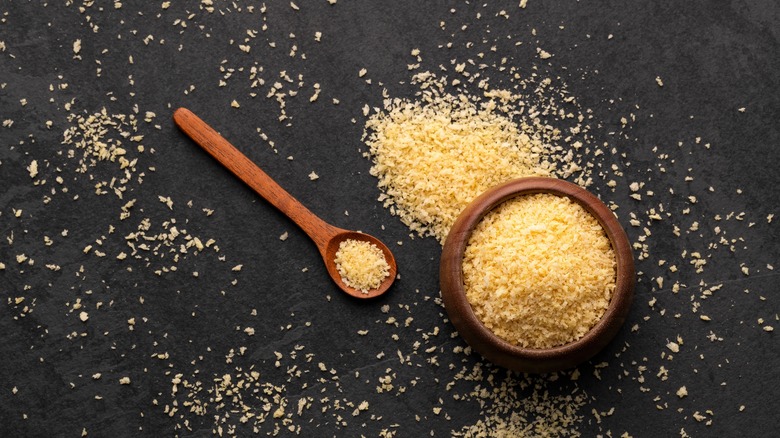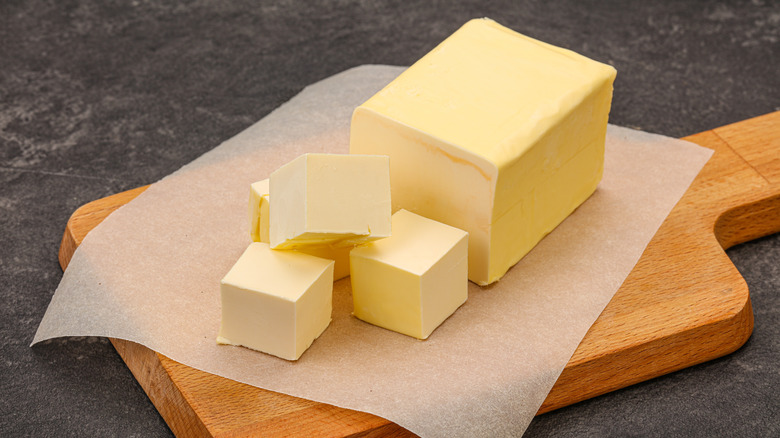12 Things That Will Take Your Chicken Parm To The Next Level
Crispy, buttery, salty, and cheesy, chicken parmesan meets all the flavor and texture requirements of a bona fide comfort food. Made by battering and frying chicken filets and then baking them in tomato sauce with plenty of mozzarella as a topping, it's a dish that is fancy enough to feature at high-end restaurants and uncomplicated enough to be made at home. Our chicken parmesan recipe, for example, takes an hour to make from start to finish, but most of that is cooking time.
Contrary to popular belief, this dish did not originate in Italy but in the U.S. During the first half of the 20th century, Italian immigrants brought their culinary traditions to America and adapted them to suit the new country and what it had to offer. Lower meat prices and difficulties finding eggplant meant that they could transform the usual vegetable-based parmigiana dishes into ones made with veal and chicken. And while eggplant parmesan in Italy is traditionally sautéed rather than breaded and fried, early recipes in America established the iron-clad rule that the chicken must be fried. Over the years, the recipe has been developed and standardized into the explosion of flavor and textures we know today. The basic formula is faultless when executed well, but that doesn't mean you can't add to it or brush up on your technique. Here are some ideas to get you started.
1. Turn it into a pasta dish
A well-rounded meal needs carbs, and although you can pair chicken parmesan with any number of starchy side dishes, you can easily adapt the recipe to include this essential element on its own and save yourself the hassle of making a separate recipe. Given the Italian-American roots of the dish, pasta is the obvious option. To make things even easier, our one-pot chicken parm pasta recipe is, as its title suggests, made in a single pot. Not only do you get to forgo making any side dishes, but you can also avoid a sink full of dirty dishes at the end of the evening.
Despite the additional element, this recipe still only takes about an hour to make, just like a standard chicken parmesan recipe. It might be a bit too much to ask on a busy weeknight, but if you do have the time to spare, consider making a double batch so you'll have plenty of leftovers in the days to come. Start by cutting the chicken into strips, breading them in a seasoned flour and breadcrumb mixture, and lightly frying them. Then, cook the pasta and the marinara together, add the chicken back in, and smother it in cheese.
2. Add pine nuts to the breading
One of the main frustrations with chicken parmesan is when that deliciously crunchy breading turns out to be not so crunchy by the end of the recipe. Sogginess is hard to avoid considering that one of the main features of the dish is a generous amount of marinara, but there are ways to fix it. One of the easiest options isn't a cooking technique or a matter of careful timing -– it's an ingredient. Adding crushed pine nuts to your chicken parmesan won't prevent the crispy breadcrumbs from getting soggy (we have more on that later), but it will provide a stand-in texture in the unfortunate event that you do end up with mushy breading. Think of it as an insurance policy that also adds flavor.
Our friends over at Tasting Table have a crispy and saucy chicken parmesan recipe made with pine nuts that proves how effective they are. The additional ingredient provides a surprisingly harmonious flavor, dialing up the nuttiness of the parmesan and adding to the richness of the cheese. A little goes a long way -– you only need a quarter of a cup for four chicken breasts –- but you'll notice the difference right away. Whether you're looking to subtly enhance the flavor, retain a bit of crunch, or both, this one ingredient has your back.
3. Use meatballs
Chicken parmesan is usually made with chicken breast meat rather than ground chicken, but there is no reason to stick to this tradition if you're looking for ways to alter the classic recipe. Instead of changing the sauce or the breadcrumbs, swap the chicken breasts for ground chicken, toss in a few seasonings, and enjoy the meatball version of this delicious dish. Think of it as two Italian-American classics rolled into one. What's not to love?
One of the best parts of this option is that you can choose any style of meatballs. If you're struggling to find a recipe that uses ground chicken, opt for one that uses ground turkey instead of ground beef. Turkey is more similar to chicken in its fat content and flavor, so you're more likely to end up with the results you were expecting. Mashed has plenty of options to take advantage of, from this quick 30-minute turkey meatball recipe to our take on Giada de Laurentiis' turkey meatballs with a twist. What's the twist? Cheese. Instead of merely smothering the meatballs in mozzarella, this recipe calls for stuffing them with it as well. It's pure gooey indulgence, and the perfect spin on chicken parm.
4. Soak the chicken in buttermilk
Soggy breading is one of the main pitfalls of chicken parmesan, but the opposite issue can arise just as easily. Dry chicken is unpleasant regardless of whether it's drenched in marinara, and it is difficult to avoid when you're working with chicken breasts. In contrast with the fattiness of thigh meat, chicken breasts are lean and full of protein. This is ideal from a nutritional perspective, but from a textural perspective, it's a liability. As the meat cooks, the protein contracts and pushes out moisture. With a cut as protein-rich and low in fat as chicken, this means that there usually isn't much moisture left by the time the meat is cooked to a safe temperature.
Luckily, there is a way to get around this seemingly intractable issue. As Tasting Table explains, buttermilk is the unconventional step for a juicier chicken parm. The fermented dairy product is full of acid, which helps break down some of the protein fibers in the meat when added to a brine or marinade. Weakened protein fibers won't be able to contract as forcefully as usual, even in high temperatures, preventing them from squeezing out the moisture in the meat. The result is tender, juicy chicken breasts with subtly enhanced flavor.
5. Be mindful of the cheese
For a lot of us, cheese is the main attraction of chicken parmesan. Without it, you'd just have some sauce-covered chicken, and while that might taste good, it can't touch the cheese-drenched deliciousness of the classic dish. Despite its name, chicken parmesan was originally made with no parmesan at all, and even now, many recipes call for mostly mozzarella. It isn't a matter of linguistic misdirection. The "parmesan" in chicken parmesan is an Anglicized version of an Italian word, "parmigiana." Historians are divided on whether that word was its own take on the word "damigiana" (the wicker sleeve used to carry casserole dishes), "palmigiana" (the palm-covered roofs that resembled layered slices of eggplant), or "parmiciana" (Persian). No matter which one, it's easy to see why mozzarella is favored for the dish over parmesan. It melts much more readily and has a pleasantly milky, mild flavor, but it isn't the only option, and you can easily swap it with others.
No matter which type you're using, your chicken parmesan needs high-quality cheese. Recipe developer Maren Epstein, whose chicken parmesan recipe calls for 2 cups of parmesan and 8 ounces of mozzarella, advises that people look for a low-moisture version of mozzarella to prevent the dreaded soggy crust. As long as you're using high-quality cheese, you can be creative. Cheddar, gouda, and even brie could add a new spin on the classic dish, and a sprinkling of feta is rarely out of place.
6. Use a thermometer when frying
Frying can be intimidating if you don't do it regularly. For one thing, it's dangerous. All that scorching hot oil spitting away can cause serious burns if it splashes onto your skin, so it's no wonder some people avoid it as a cooking method. The temperature can also damage the food. If the oil is too hot, it can burn the breading before the inside of the chicken is cooked. If the oil isn't hot enough, however, you could end up with overcooked chicken before the breading can become crispy. You'll end up with tough meat and oily breading that starts to fall off the chicken even before you remove it from the pan. To make sure you hit just the right temperature, a thermometer is a must-have item. Bring the oil to between 375 and 400 degrees Fahrenheit, add the chicken, and then turn the heat up to bring it back to that 25 degree range.
Even with a thermometer, it's easy to fall outside the recommended temperature zone. If the oil is too cold, adding heat is easy, but if it's too hot, it can be harder to cool it down fast enough to prevent the chicken from burning. Luckily, Gordon Ramsay has some advice for what to do when your frying oil gets too hot. According to the "Hell's Kitchen" star, all you have to do is turn your burner off and add some room temperature oil to the pan.
7. Use potato starch
Of the many ways to keep chicken parmesan from becoming soggy, one of the easiest and most effective is potato starch. One of the issues that frequently accompanies soggy breading is dense, tough breading. Instead of ending up with a light, crisp coating, you get a thick layer of soggy cardboard. Potato starch keeps these dual pitfalls at bay for several reasons. First, it prevents gluten formation. When wheat flour mixes with moisture, it starts to form gluten and become rubbery. Think of the way bread flour becomes more elastic as you knead it –- that's gluten formation. Starch, which has no gluten, provides a more delicate coating that can be thick without becoming gluey. Many fried chicken recipes use cornstarch for this reason, but potato starch is an even better option because it has larger starch granules than cornstarch, allowing for the moisture in the chicken to more quickly evaporate when fried.
The key to adding potato starch to a breading recipe is to use moderation. If you use too much starch, you'll end up with a mixture that is so crumbly it won't stick to the chicken. Replacing ¼ of the flour with potato starch is the sweet spot. So, if the recipe calls for 1 cup of flour, use ¾ of a cup of flour and ¼ of a cup of starch.
8. Add wine to the sauce
A good tomato sauce requires time. You can't simply throw some canned tomatoes in a pan with seasonings and olive oil and expect it to taste like restaurant quality sauce by the time it heats up. The longer the ingredients cook, the more their flavors deepen into a powerful reduction that will transform your pasta dishes and, of course, your chicken parmesan. Our recipe for homemade tomato sauce requires two to three hours of simmering, but it is unquestionably worth it.
If you do have a few hours to spare for making sauce, you can add even more flavor to it by sneaking in a few glugs of wine. It will cut through the oil in the sauce, enhance the other ingredients, and add a rich depth. The best way to add it is to deglaze the pan. Pouring a little liquid into a hot skillet (even water) helps dislodge pieces of food from the bottom and incorporate the flavors into the dish. When you do it with wine, you get a double dose of flavor. Just make sure you leave the sauce cooking long enough to burn off most of the alcohol. You won't be able to burn it all off, but letting the sauce simmer at a minimum of 173 degrees Fahrenheit (the boiling point of alcohol) for at least half an hour will get rid of about 65% of it (per Idaho State University).
9. Marinate the chicken
Chicken parmesan is bursting with flavor, but one element that can be a weak link in the chain is the chicken itself. Chicken breasts do not have anywhere near the amount of flavor as darker cuts of meat, and one of the best ways to solve the problem is to marinate it first. Not only will it make the chicken tastier, but, if it includes some acidity, it can weaken the protein fibers in the meat and prevent them from contracting and squeezing out the moisture. Marinating the chicken is an extra step that will need to be done in advance of starting the regular recipe, but as long as you plan ahead, it's an easy option that will be more than worth it once you take your first bite of juicy, flavorful meat.
The folks over at Tasting Table have a few pointers for making marinated chicken parmesan. The first is to choose the marinade wisely. For example, a marinade made with peanut butter might be delicious when you're making chicken pad thai, but it probably won't make your taste buds sing when added to a dish with tomato sauce and cheese. Opting for something that has acid and complementary flavors is a necessity. Our simple chicken marinade recipe is a good place to start. Made with garlic, olive oil, vinegar, brown sugar, salt, and pepper, it provides acidity and flavors that will dovetail perfectly with the flavors of chicken parmesan.
10. Swap chicken breasts for chicken thighs
One of the most consistent elements in chicken parmesan recipes is the use of chicken breasts. This cut of meat is full of protein, has a neutral flavor, and comes in perfectly sized portions, but it also has plenty of downsides. It's so full of protein that it can easily become tough, and even when you poach it, it can turn out dry. Its bland flavor can also be a downside unless you plan to marinate it. An obvious solution that is rarely utilized is to simply abandon chicken breasts altogether and switch to thighs. The dark meat is juicier and more flavorful than breast meat, and as it cooks, the fat melts and incorporates with the rest of the ingredients to form an even more succulent sauce.
When buying thighs for a chicken parmesan recipe, make sure to get a skinless version. Skin-on thighs have a little more flavor but are impractical for this dish because they tend to remain rubbery and fatty. Once you cover them in stringy mozzarella, they are difficult to remove and end up detracting from the melty, crispy texture of the rest of the dish. If you want maximum flavor, use bone-in thighs. However, if you prefer not to eat around the bones, boneless, skinless thighs will still provide significantly more flavor and tenderness than breast meat.
11. Upgrade the breadcrumbs
Adding potato starch to the flour mixture can work wonders on the texture of chicken parmesan breading, but what about the breadcrumbs? The sky is the limit for how you can incorporate flavor into this element of the recipe, and we have some ideas to get you started. Your spice rack is a good place to begin. Powdered ingredients are easily incorporated into breadcrumbs, and fortunately, they can bring a lot of flavor. Aside from salt and pepper, garlic and onion powder are ideal options. If you're using dried herbs, Italian seasoning will dial up the Italian-American roots of the dish, while parsley, oregano, and basil will add a touch of harmonious flavor individually or together.
When it comes to fresh ingredients, it's best to stick with ones that won't burn when fried and are chopped finely enough to be incorporated into the breading mixture. Minced, fresh herbs can be used instead of dried herbs, while lemon zest will add a bright acidity to make the chicken taste like a delicious main dish all by itself.
If you're looking for spicy ingredients to take your breadcrumbs to the next level, there is no shortage of options. Chili flakes will add a hint of ruby red color and heat, while chili powder will blend seamlessly with the breading mixture but pack a serious punch in the flavor department.
12. Add butter to the frying oil
When you think about adding flavor to chicken parmesan, you might think about throwing some surprise ingredients into the sauce or the breadcrumbs, switching up the cheese, or changing the type of chicken you're using, but there is another option. Courtesy of Gordon Ramsay, it has now been established that the simple trick for delicious chicken parmesan is to add a little butter to the frying oil. This is not a mandatory step, and if you are just getting to grips with frying and would rather keep things predictable, you can still make a gloriously flavorful dish without it, but if you are looking for new ways to take your chicken parm to the next level, this one delivers every time.
Ramsay provides a detailed roadmap for this technique in an episode of "The F Word." First, he advises using less oil than you might expect. Instead of drowning the chicken, he suggests using only a tablespoon. Once the oil is hot, add the chicken (it should make a hissing sound when it hits the pan). When the chicken starts to develop some color, place small pieces of butter around the edges of the meat to melt into the oil. Cook each side for two and a half minutes, remove the chicken from the pan, and continue with the usual recipe.
